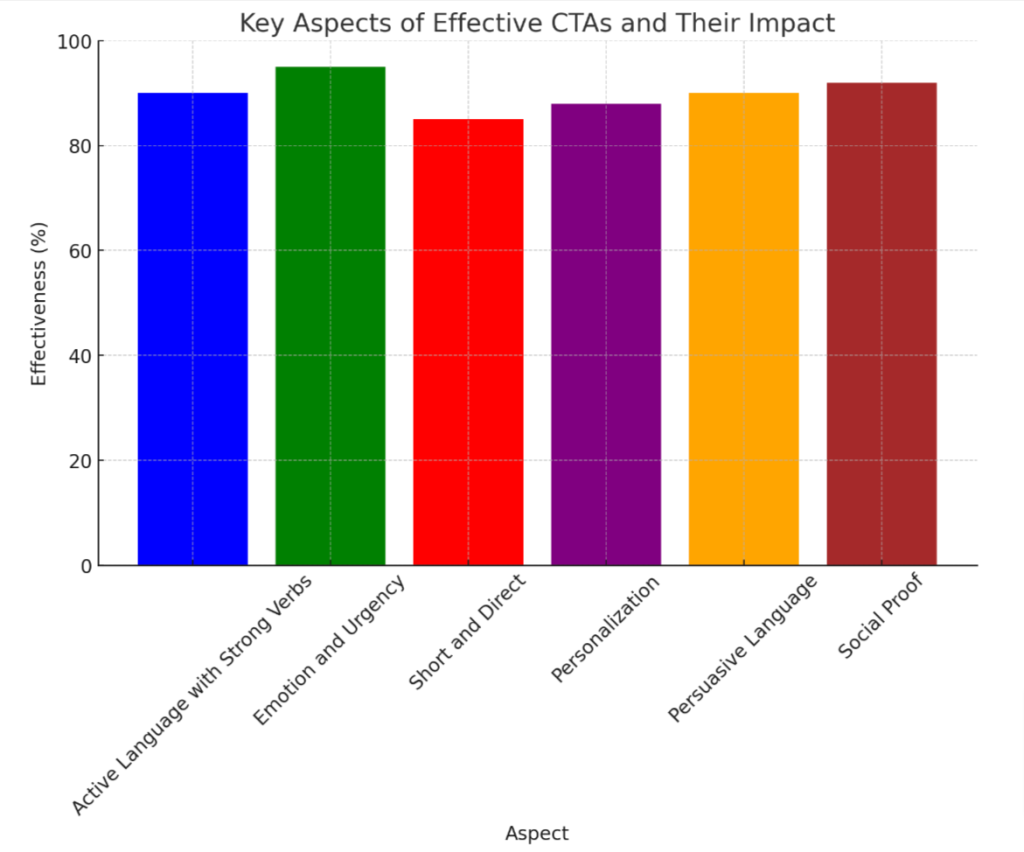Crafting Compelling Calls to Action: Strategies for Boosting Conversions
Are you struggling to convert your website visitors into loyal customers? Statistics reveal that compelling Calls To Action (CTAs) can increase conversion rates by up to 147%. This blog post will provide insightful tips on crafting CTAs that truly resonate with your audience and drive conversions.
Ready for a game-changing shift in your marketing strategy?.
Key Takeaways
- Compelling calls to action (CTAs) can increase conversion rates by up to 147%.
- Effective CTAs use active language with strong verbs and provoke emotion and urgency.
- Keeping CTAs short, direct, and personalized for the audience increases the likelihood of conversion.
- Persuasive language and social proof in CTAs help build trust and credibility.
What is a Call to Action (CTA)?
A Call to Action, commonly known as a CTA, is the prime mover that nudge your audience towards action. It’s like the dazzling neon sign on a dark street, beckoning people into an exciting new store or restaurant.
You’ll often find these CTAs showcased in emails, websites and social media platforms in diverse forms including buttons, banners or just plain text. Their main goal? To engage visitors and drive them to complete certain tasks – such as subscribing to a newsletter, making a purchase or downloading content.
In digital marketing parlance – think of CTAs as pivotal conversion optimizers. They play a critical role in steering your potential customers along their journey from mere bystanders to active participants or buyers.
Crafting compelling CTAs demands skill: they should be easy-to-spot yet unobtrusive; clear but creative; persuasive without being forceful! A well-crafted CTA can give you the competitive edge by boosting customer conversions significantly.
Tips for Writing an Effective CTA
To write an effective CTA, use active language with strong verbs, provoke emotion and create urgency, keep it short and direct, personalize for your audience and focus on benefits, and use persuasive language and social proof.
Use active language with strong verbs
Active language infuses your calls to action with a sense of urgency and purpose. Strong verbs propel visitors towards conversion, acting as the driving force that spurs them into taking decisive steps.
Using static or passive phrases might diminish their enthusiasm, creating a disconnect between what you offer and their immediate needs.
An example of weak call-to-action verb usage could be “Consider signing up for our newsletter.” This lacks immediacy and allows for procrastination. Compare this to “Secure your spot in our exclusive community now!” Here, ‘secure’ denotes action on part of the reader while ‘now’ emphasizes instant gratification.
By leveraging powerful calls to action loaded with dynamic verbs, you boost customer conversions significantly. Crafting compelling CTAs proves essential in improving conversion rates and maximizing engagement.
Provoke emotion and create urgency
Stirring the reader’s feelings propels action. Harnessing emotive language in your calls to action (CTA) makes users connect with your message on a deeper level, tapping into their desires, fears, or aspirations.
By aligning your CTA with these emotions, you make it more compelling and hard to resist. Besides emotion, inject urgency into your CTAs as well. Utilizing words such as “now”, “today,” or “limited” signal scarcity and make readers feel they might miss out if they don’t act swiftly.
Crafting a successful call to action integrates both emotional appeal and a sense of urgency; this dynamic pairing enhances conversion potential by sparking immediate responses from users.
Keep it short and direct
To create an effective call to action, it’s important to keep it short and direct. Use concise language that gets straight to the point and avoid any unnecessary fluff or jargon. By keeping your CTA short, you make it easier for your audience to understand and act upon.
Remember, you only have a few seconds to capture their attention, so make every word count. Directness is key in guiding your audience towards the desired action without any confusion or ambiguity.
So be clear, be concise, and get straight to the point with your calls to action for maximum conversion success.
Personalize for your audience and focus on benefits
To write a strong call to action, it’s essential to personalize your message for your specific audience and highlight the benefits they will gain. Tailoring your CTA to resonate with their needs and interests helps create a connection and increases the likelihood of conversion.
Instead of using generic language, use words and phrases that speak directly to your target audience. Additionally, emphasize the value or advantages they can expect by taking the desired action.
By doing so, you provide a clear incentive for users to act and increase the chances of them converting into customers or leads. Boost conversion rates by personalizing CTAs and highlighting benefits!
Use persuasive language and social proof
Persuasive language and social proof play a crucial role in crafting effective calls to action. By using persuasive language, you can create a sense of urgency and enthusiasm that motivates your audience to take action.
Strong verbs like “get,” “grab,” or “claim” inspire immediate response. Additionally, incorporating social proof, such as testimonials or success stories from satisfied customers or students, helps build trust and credibility.
When people see that others have had positive experiences with your school or product, they are more likely to convert. So make sure to use persuasive language and leverage the power of social proof in your calls-to-action for maximum conversion impact.
Examples of Strong Calls to Action
Facebook, Instagram, email, and website CTAs offer valuable opportunities to engage with your audience. By incorporating your school’s value proposition into these calls to action, you can effectively communicate the benefits of choosing your institution.
Additionally, utilizing design and visual hierarchy can enhance the impact of your CTAs and drive conversions. Don’t forget to conduct tests to determine the most effective CTA for your target audience.
Facebook, Instagram, email, and website CTAs
Boost your conversion rates by utilizing effective calls to action on popular digital platforms such as Facebook, Instagram, email, and your website. Take advantage of these platforms to engage with your audience and guide them towards your desired action. Use strong verbs and persuasive language that provokes emotion and creates a sense of urgency. Personalize the CTAs based on your audience’s interests and focus on the benefits they will gain. Additionally, incorporate social proof to enhance credibility and encourage conversions. Test different CTAs to find the most effective ones for each platform.
Incorporating school’s value proposition
Incorporating your school’s unique value proposition into your calls to action can significantly enhance their effectiveness. Highlighting what sets your institution apart from others will grab the attention of prospective students and parents, motivating them to take action.
Emphasize the benefits and advantages that students can gain by choosing your school, whether it’s exceptional academic programs, state-of-the-art facilities, or a supportive learning environment.
By incorporating your school’s value proposition into your CTAs, you can effectively communicate why potential students should choose your institution and drive conversions.
Utilizing design and visual hierarchy
Design and visual hierarchy play a crucial role in crafting effective calls to action. By utilizing design elements such as color, size, and placement, you can guide the user’s attention towards your call to action button or link.
A strategically placed CTA that stands out from the rest of the page can significantly increase its visibility and encourage conversions. Additionally, using contrasting colors for your CTA button can make it more prominent and grab users’ attention.
Remember to keep the design clean and uncluttered so that your CTA stands out without distractions.
Conducting tests for the most effective CTA
To maximize the effectiveness of your call to action (CTA), it’s essential to conduct tests and experiments. By testing different variations of your CTA, you can determine which elements resonate most with your audience and drive the highest conversion rates.
Experiment with different wording, colors, placement, and design to optimize your CTAs for maximum impact. Using A/B testing or multivariate testing methods will help you make data-driven decisions about what works best for your specific goals and target audience.
Continuously analyzing the results of these tests will enable you to refine and improve your CTAs over time, ultimately boosting conversions and enhancing overall campaign success.
Common Mistakes to Avoid when Writing a CTA
Using friction words and failing to minimize risk can hinder the effectiveness of your CTA. It’s important to create a smooth user journey by eliminating any obstacles or concerns that may discourage potential conversions.
Additionally, always double-check your links to ensure they are functioning properly and directing users to the intended destination.
Friction words and minimizing risk
Minimizing risk and using language that reduces friction are crucial when writing a strong call to action. By avoiding words or phrases that may create hesitation or doubt, you can increase the likelihood of conversion.
Instead, focus on conveying confidence and trust in your offer. Use direct and clear language to guide your audience towards taking action without any unnecessary obstacles.
Creating a smooth user journey
Creating a smooth user journey is crucial for driving conversions and enhancing the effectiveness of your calls to action (CTAs). When visitors encounter friction or obstacles during their interaction with your website or landing page, they are more likely to abandon the process.
To ensure a seamless experience, pay attention to elements such as page loading speed, intuitive navigation, and clear instructions. Additionally, optimize your forms by keeping them simple and easy to fill out.
By focusing on creating a smooth user journey, you can increase the chances of users completing desired actions and boosting conversion rates.
Checking links
Checking links is a crucial step in ensuring the effectiveness of your calls to action. By verifying that all links included in your CTAs are working properly, you can prevent any potential frustration or disappointment for your audience.
Broken or incorrect links can lead to missed opportunities for conversions and damage the overall user experience. Take the time to click on each link and make sure it directs users to the intended landing page.
This simple task will help boost the success rate of your calls to action and enhance conversion rates.

Conclusion
In conclusion, crafting strong calls to action is essential for driving conversions. By using active language with strong verbs and provoking emotion, you can create a sense of urgency that motivates your audience to take action.
Keep your CTAs short and direct, personalize them for your specific audience, and use persuasive language and social proof to build trust. With these tips in mind, you can improve your conversion rates and maximize the impact of your calls to action.

